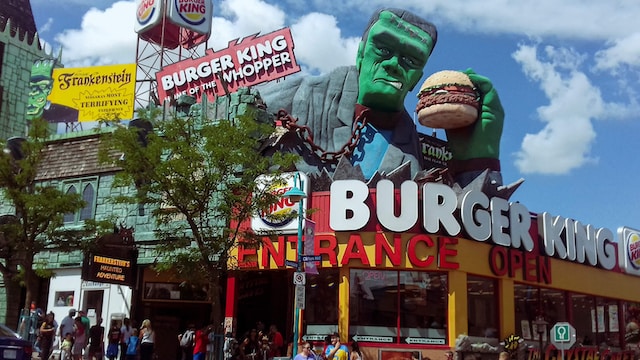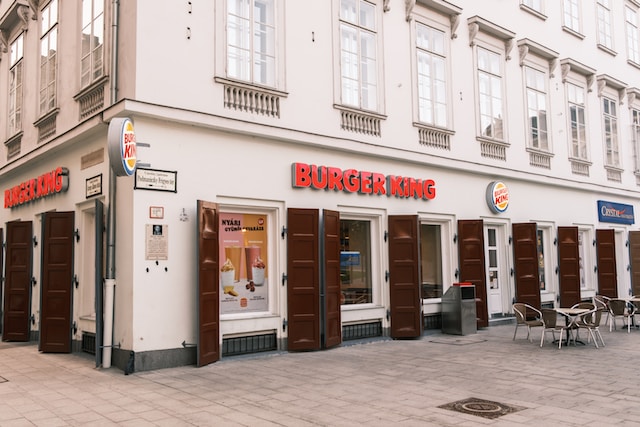Burger King is one of the largest fast-food chains in the world, with over 18,000 locations globally harmonized. Its success can be attributed to its delicious menu offerings and strategic real estate approach, making it among the best net lease investments you could make.
This article will cover Burger King’s real estate requirements, including the site selection process, average lease rates, potential return on investment, and how NNN Deal Finder can assist you in acquiring a Burger King building.
An Overview of Burger King
Established in 1954, Burger King is the second largest fast-food chain globally (behind McDonald’s). Interestingly, its founders, Keith J. Cramer and Mathew Burns, were initially inspired by the first McDonald’s store in California.
They would go on to establish the first Burger King restaurant in Florida, cooking burgers for customers using an Instant Broiler. Eventually, the company was purchased by James McLamore and David R. Edgerton after experiencing struggles in its early years.
The pair would rename the company “Burger King” and expand the brand to over 200 locations across America. Today, Burger King stretches across 19,700 restaurants worldwide, boasting over $5 billion net worth.
Aside from its world-famous beef burgers, Burger King also sells non-beef and vegetarian dishes, including chicken and meatless sandwiches. The brand also offers gift card services.
How Burger King Selects Their Site Locations
Demographics
Like most fast food restaurants, Burger King’s traditional locations feature dense populations and high foot traffic, as these areas are more likely to generate a steady flow of customers.
By carefully considering factors such as median income, age distribution, and population growth, the company can identify areas that are not only demographically compatible with their target audience but also offer sustainable growth potential.
This meticulous approach to site selection enables Burger King to maximize the chances of success for its fast-food restaurant franchises, ensuring a steady stream of revenue and a strong return on investment for each property.
The company’s ability to pinpoint neighborhoods with favorable demographic profiles allows it to expand its global footprint while maintaining its reputation as a leading fast-food chain.

Accessibility
Easy access to Burger King restaurants is of paramount importance for the company, as it directly impacts customer convenience and overall satisfaction. Prioritizing real estate properties with good visibility ensures potential patrons can quickly and easily identify the restaurant, making it an attractive option for casual and loyal customers.
Ample parking plays a critical role in accommodating drive-thru service and dine-in guests, especially in suburban and high-traffic areas where convenience is key. Additionally, proximity to public transportation options enables Burger King to cater to a broader audience, including commuters and those without personal vehicles.
By focusing on accessibility, the fast food restaurant creates a welcoming and efficient environment that enhances the customer experience and encourages repeat visits, ultimately contributing to the success and growth of the franchise.
Co-tenancy
Burger King’s strategic approach to selecting locations involves targeting shopping centers with high-performing anchor stores and complementary businesses. This tactic enables the fast-food chain to tap into the existing customer base that frequents these retail hubs, increasing foot traffic and fostering synergy with other establishments.
By situating itself close to popular retail destinations, Burger King can effectively capitalize on the natural flow of consumers in the area, offering them a convenient and appealing dining option.
This co-tenancy strategy not only helps to drive sales but also strengthens the overall appeal of the shopping center, creating a mutually beneficial business relationship between Burger King and its neighboring businesses.
Trade Area Analysis
Burger King’s comprehensive trade area analysis is a vital component of its real estate selection process, as it helps them evaluate the viability of a potential location. By examining factors such as market size, competition, and existing retail mix, Burger King can make informed decisions regarding the suitability of a specific site for its business model.
Meticulous evaluation enables the company to identify areas where it can establish a competitive edge and avoid oversaturated markets that may hinder its growth potential.
Ultimately, this data-driven approach to site selection ensures that Burger King franchises are well-positioned to succeed and thrive within their respective trade areas, reinforcing the company’s commitment to long-term, sustainable expansion.
Trade area analysis is perhaps the most critical factor for interested Burger King investors, as it can help discover restaurant locations with substantial potential to yield investment returns. While you’ll likely have eyes on traditional restaurant sites, in-depth market analysis can help you spot non-traditional locations with revenue potential.

Site Characteristics
The ideal site for a Burger King restaurant is a crucial aspect of ensuring the success and profitability of each franchise. With a parcel size ranging from 20,000 to 30,000 square feet, the company can accommodate its restaurant layout, including dining areas, kitchen facilities, and storage spaces.
Furthermore, having at least 100 feet of frontage on a primary roadway is essential for providing optimal visibility and accessibility to passing traffic, enticing potential customers to visit the restaurant building.
Another critical component of the site selection process is providing adequate space for drive-thru service, which has become an increasingly important revenue stream for fast-food chains.
By meeting these specific site requirements, Burger King ensures that each restaurant is primed for success and can effectively cater to the needs and preferences of its diverse customer base.
Average Burger King Lease Rates
Lease rates for Burger King restaurants are influenced by various factors, making it essential for a potential Burger King franchisee to carefully assess their options and conduct thorough research.
The site’s location, size, and existing infrastructure play significant roles in determining lease rates, which can vary considerably depending on the specific circumstances. On average, lease rates for a Burger King restaurant range from $60,000 to $100,000 per year. However, this figure can fluctuate depending on the area’s demand and property values.
In prime urban locations with high foot traffic and greater competition for real estate, lease rates are often higher due to the increased desirability of these sites. Conversely, rural or suburban areas with lower population density and less commercial demand may offer more affordable lease rates, making them attractive options for franchisees seeking lower overhead costs.
In addition to the lease rates, the franchise owner should also be prepared for building improvement payments, which encompass the expenses associated with fitting out the restaurant space to meet the franchisor’s specifications, especially regarding brand standards and operational requirements.
These real estate costs can vary widely based on factors such as the condition of the existing building, the need for specialized equipment, and local property construction costs. That said, Burger King has a modernization plan and is willing to offer incentives to interested investors willing to undergo restaurant remodels.
By carefully considering the aforementioned factors as a potential Burger King franchisee, you can make informed decisions about the financial feasibility of a specific location and develop a comprehensive understanding of the total investment required for a successful Burger King franchise.
Is Burger King a Good Investment?
Investing in a Burger King franchise presents a potentially lucrative opportunity for investors well-suited to the fast-food industry’s demands. The company is one of the most successful restaurant brands globally, with net sales totaling $1.9 billion in 2022.
As a globally recognized establishment, Burger King boasts a loyal customer base that appreciates its signature offerings, quality service, and consistent dining experience. The company’s efficient business model, which emphasizes cost-effective operations, innovative marketing, and strategic site selection, further contributes to the high success rate of its franchises.
Interestingly, the Burger King Corporation has accelerated its yearly net restaurant growth over the last two decades. In 2010, the fast-food restaurant brand added 173 new units to its restaurant locations. By 2016, this figure had increased to over 700 new sites. The increase in new units across the years is a testament to the company’s commitment to expansion. It’s also excellent news for investors seeking opportunities to invest with the Burger King Corporation.
The return on investment for a Burger King franchise, however, is not guaranteed and will depend on various factors, such as the location’s demographics, the management team’s competence, and the lease agreement’s specific terms. Investors who diligently address these factors and actively monitor the performance of franchisor-owned restaurants can potentially generate annual net profits of 10% to 20% of the initial investment cost.
This substantial return speaks to the strength of the Burger King brand and the potential for financial success in the fast-food industry. It is essential for prospective franchisees to carefully evaluate their capacity to manage and support a Burger King franchise, as well as to conduct thorough research on the market conditions and competition in their desired location.
By doing so, you can increase the likelihood of a successful and rewarding business investment in a Burger King franchise, benefiting from the company’s established brand reputation and proven business model.
Acquiring a Burger King Store with the Help of NNN Deal Finder
Despite being a relatively profitable portfolio with little hands-on commitments, NNN investments like Burger King franchises can be tricky to navigate for first-time investors. As a result, you’ll need expert assistance to reap the benefits of these commercial properties.
NNN Deal Finder is an invaluable resource for investors looking to acquire a Burger King restaurant. We specialize in locating triple net (NNN) properties, which are attractive investments because the tenant (in this case, Burger King) is responsible for all property-related expenses, including taxes, insurance, and maintenance.
This arrangement results in a more predictable income stream for investors. Our team at NNN Deal Finder can help you identify suitable Burger King locations, negotiate lease terms, and conduct due diligence to ensure a smooth acquisition process.
With our extensive expertise in the NNN market, we will give you the confidence to make informed decisions and maximize your investment spending. Contact us to check out some of America’s best Burger King real estate locations.
Conclusion
Burger King’s strategic approach to real estate has contributed to its global success as a fast-food giant. By understanding their site selection process, average lease rates, and potential ROI, investors can make informed decisions about acquiring a Burger King franchise. With the help of NNN Deal Finder, prospective investors can navigate the acquisition process with ease and confidence.
Give our team a call to discuss Burger King’s real estate requirements and the investment opportunities you can find within them.

